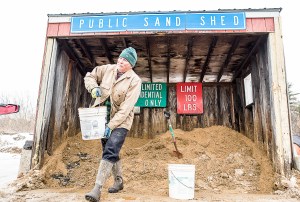LEWISTON — City officials across Androscoggin, Franklin and Oxford counties agree that the wet and icy winter has led to above-average use of road salt and a few delivery hiccups, but no one is hitting the panic button — yet.
Officials are hoping that Mother Nature cooperates for the remainder of the season.
“It’s been tight lately, but not critically,” said Dale Doughty, director of maintenance and operations for the Maine Department of Transportation, referring to road salt deliveries.
He said the state — and some municipalities — have experienced brief shortages because of late deliveries or scheduling conflicts. The missed deliveries are normally due to weather. He said the department keeps a close eye on the status of all shipments within its five regions.
“You never know what’s going to happen,” he said.
Doughty said the state has used more salt than in previous years because of the recent spell of sleet and freezing rain, but stockpiles remain at a “comfortable” level.
In Lewiston and Auburn, salt and sand use is so far average, despite the slick conditions.
David Jones, director of Lewiston Public Works, said Thursday that there is no issue with the city’s winter supply. He said Lewiston, as well as other cities, generally stockpile early in the season. He said during the last storm, officials from Auburn contacted Lewiston because they hadn’t received a salt delivery they were expecting.
In Auburn, Public Services Director Dan Goyette said the city’s sand and salt budget is “on track” for the year.
“It’s a pretty normal year in terms of usage,” he said Thursday.
He said the city contracts with Eastern Salt Co., based in South Portland. The company could not be reached for comment Thursday.
The cities have contracts with sand and salt suppliers, but said they haven’t heard anything about regional shortages of either.
Eric Conrad, director of communication and educational services for the Maine Municipal Association, said Thursday that he’s heard from three larger municipalities in the state concerning their usage. He said two have reported good supply, and one is running low and “looking to refill.”
“None of them seem too worried yet,” he said. “All three agreed they ended last winter with supply on hand.”
Doughty said the state uses much more road salt than sand during winter storms, while cities and towns tend to use more sand in their mixtures. He said the state normally stockpiles what it needs in sand, which can last a few seasons.
The Maine Department of Transportation generally goes through two salt companies: Morton Salt and Harcros Chemicals.
Paul Jackiewicz, senior communications manager for Morton Salt, said the company “produces and stockpiles salt year-round to keep a steady supply available to customers, and works closely with customers to prepare for and manage their road salt supply throughout the winter season.”
Doughty said regional sand supplies normally come from local gravel pits, which tend to stay open throughout the winter. In Lewiston and Auburn, that means places like St. Laurent & Son.
Asked if any effort is made to recycle materials, Doughty said salt is difficult because it dissolves, but it’s possible to reuse sand after it is screened.
For smaller municipalities, like those in Franklin and Oxford counties, the local sand supply is sometimes a point of contention, with some people abusing rules at sand sheds that supply free sand, but at a limit.
In the past few years, towns have cracked down on the volume of sand each person can take for personal use.
“We have not implemented any new rules,” said John Johnson, Jay public works director.
Johnson added that the town’s sand and salt use is a little ahead of where it should be, “but, if this darn icing stops we’ll be fine.”
Canton Selectman Don Hutchins said the town has enough sand and salt to get through the winter, but they’ve had some problems with people from out of town stealing sand and they have sent letters to those people telling them to stop.
In Lewiston and Auburn, each city operates a public sand shed, where residents can take a limited amount of sand. Both departments have dealt with residents, or even contractors, loading up trucks full of free sand.
In Auburn, sand is available at the facility on Gracelawn Road. Goyette said residents are allowed to take four 6-gallon pails. He said so far this year, they haven’t had to limit or deny access to the sand shed. In Lewiston, residents are allowed two 5-gallon pails.
Other regional towns have also used more materials due to the wintry mix, which has refrozen multiple times.
George Finch, town manager in Harrison, said, “There has been a significant impact on sand and salt” because of the kind of weather seen so far. He said they’ve “dug deeply” into their annual supply but have been covered by funds that weren’t used during last year’s mild winter.
But, Finch said, “A lot of towns are in far worse condition than we are.”
In Buckfield, Town Manager Cindy Dunn said the budget looks good for now, but that it always depends on Mother Nature.
“Let’s hope she wants to see spring sooner than later — as we all do,” Dunn said.
So far this winter, Farmington Public Works has used 4,000 cubic yards of sand, and on average uses 5,000 during an entire winter, said Director Philip Hutchins. He said the town’s road salt supplier has been dependable, with only a slight delay occuring lately.
The delay was due to inclement weather, he said.

Comments are no longer available on this story